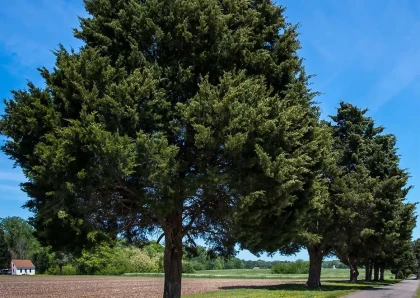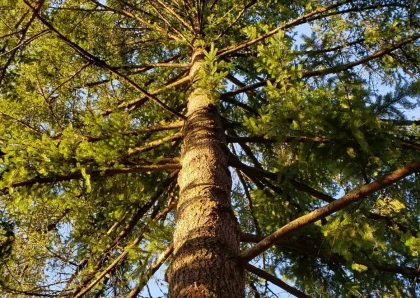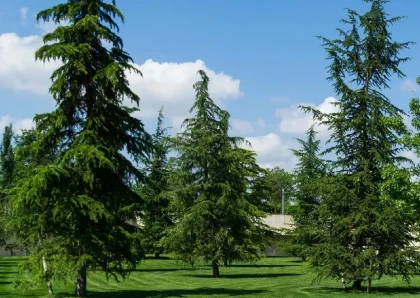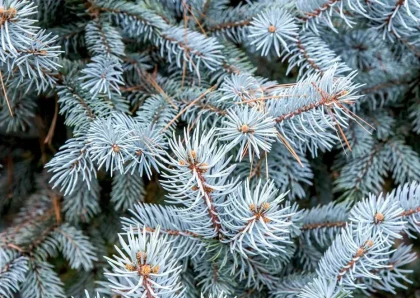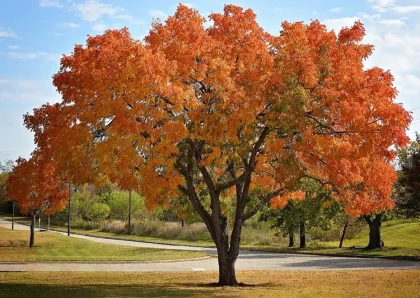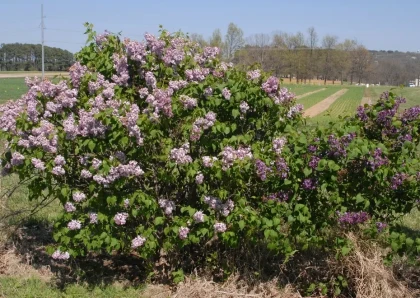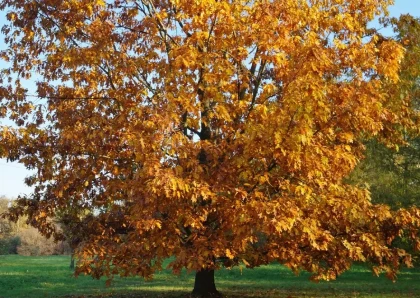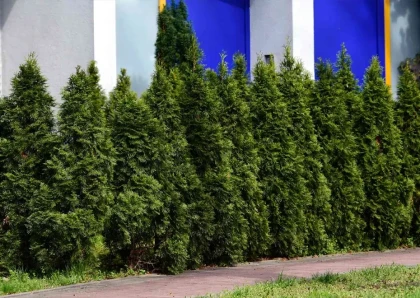
Dawn Redwood Tree
Overview
The Dawn Redwood tree, scientifically known as Metasequoia glyptostroboides, is a deciduous coniferous tree that belongs to the family Cupressaceae. It is a unique and remarkable species because it was once thought to be extinct for millions of years until living specimens were discovered in the mid-20th century.
Key Characteristics
- Fossil history: Fossils of the Dawn Redwood date back to the Mesozoic era, around 100 million years ago. They were known only from the fossil record until living trees were found.
- Deciduous nature: Unlike most conifers, the Dawn Redwood is deciduous, meaning it sheds its needles in the autumn.
- Size: The tree can grow to impressive heights, often reaching 70 to 100 feet (about 21 to 30 meters) or more.
- Needles: The needles are soft and feathery, arranged in a spiral pattern on the branches. In the spring and summer, the needles are green, but they turn a beautiful reddish-brown or golden-brown in the fall before dropping.
- Cones: Dawn Redwood produces small, rounded cones that contain its seeds. The cones disintegrate to release the seeds in the fall.
- Growth rate: The tree is known for its fast growth rate, especially when it is young.
Cultivars of the Dawn Redwood Tree
- Metasequoia glyptostroboides 'Gold Rush': Golden-yellow foliage in the spring, turning green later.
- Metasequoia glyptostroboides 'Ogon': Striking golden foliage throughout the growing season.
- Metasequoia glyptostroboides 'Miss Grace': Narrow and weeping growth habit.
Different Wood Products from the Dawn Redwood Tree
- Lumber: Dawn Redwood wood can be used for producing lumber, which is widely utilized in construction and woodworking projects. Its lightweight nature and resistance to decay make it suitable for various indoor applications.
- Furniture: The wood from Dawn Redwood trees can be fashioned into furniture pieces like tables, chairs, cabinets, and shelves. Its straight grain and attractive reddish-brown color lend themselves well to furniture design.
- Cabinetry: The stable nature of Dawn Redwood wood makes it suitable for crafting cabinets in kitchens, bathrooms, and other living spaces.
- Flooring: Dawn Redwood lumber can be processed into hardwood flooring, providing an elegant and durable option for homes and commercial spaces.
- Panelling: The wood can be used for wall paneling, adding a warm and natural aesthetic to interior spaces.
- Siding: Due to its natural resistance to decay, Dawn Redwood wood can be utilized for exterior siding, giving buildings a distinctive look.
- Boat Building: Dawn Redwood wood has been used in boat building, especially for smaller boats and canoes, thanks to its buoyant properties.
- Sculptures and Artwork: The unique properties of Dawn Redwood wood make it a sought-after material for sculptors and artists who wish to create intricate and detailed pieces.
- Wood Crafts: The wood is also popular for crafting smaller items such as decorative pieces, wooden toys, and other handmade crafts.
- Musical Instruments: Some musical instruments, like guitars and ukuleles, have been crafted using Dawn Redwood wood due to its tonal properties.
Benefits of the Dawn Redwood Tree
The Dawn Redwood tree (Metasequoia glyptostroboides) offers numerous benefits, both ecological and practical, making it a valuable and beneficial species. Here are some of the key benefits of the Dawn Redwood tree:
- Environmental Benefits:
- Carbon Sequestration: Like other trees, Dawn Redwoods play a vital role in sequestering carbon dioxide from the atmosphere, helping to mitigate climate change.
- Air Purification: Trees, including Dawn Redwoods, help improve air quality by absorbing pollutants and releasing oxygen through the process of photosynthesis.
- Ecological Significance:
- Biodiversity Support: Dawn Redwood trees provide habitat and food for various wildlife, including birds, insects, and mammals, contributing to local biodiversity.
- Erosion Control: The extensive root system of Dawn Redwood trees helps stabilize soil, preventing erosion in areas prone to landslides or runoff.
- Aesthetics and Landscaping:
- Ornamental Value: The Dawn Redwood's unique appearance, with its feathery foliage and reddish-brown fall color, makes it a popular choice for landscaping and ornamental purposes.
- Shade and Cooling: Large Dawn Redwood trees can provide shade, reducing heat in urban areas and creating more comfortable outdoor spaces.
- Wood Production:
- Quality Wood: The wood from Dawn Redwood trees is lightweight, relatively durable, and has an attractive reddish-brown color, making it suitable for various woodworking projects.
- Sustainable Harvesting: Properly managed plantations of Dawn Redwood trees can provide a renewable source of wood products.
- Educational and Research Value:
- Living Fossils: Dawn Redwood trees are living fossils, offering insights into the Earth's ancient past and evolutionary history.
- Botanical Research: Scientists and researchers study Dawn Redwood trees to understand their growth patterns, adaptations, and ecological roles.
- Cultural and Historic Significance:
- Cultural Symbol: In their native range and beyond, Dawn Redwood trees hold cultural significance as symbols of longevity, resilience, and natural beauty.
- Historic Interest: The discovery of living Dawn Redwoods in China in the 1940s was a significant botanical event, enriching our understanding of plant evolution and paleobotany.
- Tourism and Recreation:
- Natural Attractions: Dawn Redwood trees can become iconic attractions, drawing visitors to botanical gardens, parks, and natural reserves.
- Recreational Spaces: Dawn Redwood stands can provide tranquil and scenic areas for recreational activities such as hiking and nature walks.
Tips for Planting and Maintaining a Dawn Redwood Tree
Planting:
- Selecting the Location: Choose a planting site with full sun or partial shade. Dawn Redwood trees can tolerate various soil types but prefer well-draining, moist, and slightly acidic soil.
- Space Requirements: Ensure you have enough space for the tree to grow to its full size, as Dawn Redwoods can reach significant heights and widths.
- Planting Time: The best time to plant a Dawn Redwood tree is in the early spring or fall when the soil is moist and the temperatures are moderate.
- Digging the Hole: Dig a hole that is slightly larger than the tree's root ball. Loosen the soil around the edges to encourage root penetration.
- Planting Depth: Plant the tree at the same depth it was in the nursery container, ensuring the top of the root ball is level with the ground.
- Backfilling: Fill the hole with soil and water thoroughly to settle the soil and remove air pockets around the roots.
- Mulching: Apply a layer of organic mulch around the base of the tree to retain moisture, regulate soil temperature, and suppress weed growth. Avoid piling mulch against the trunk.
Watering:
- Establishment Period: Water the newly planted Dawn Redwood tree regularly during the first year, especially during dry spells. Keep the soil consistently moist but not waterlogged.
- Mature Trees: Once established, Dawn Redwoods are generally drought-tolerant, but during prolonged dry periods, deep watering is beneficial.
Pruning:
- Early Pruning: Young trees may benefit from light pruning to shape their growth and promote a strong central leader.
- Minimal Pruning: Dawn Redwood trees have a natural pyramidal shape, and excessive pruning should be avoided to maintain their aesthetic appeal.
Fertilizing:
- Youth Trees: During the first few years, a balanced, slow-release fertilizer can be applied in early spring to support healthy growth.
- Mature Trees: Once established, Dawn Redwood trees generally do not require regular fertilization unless there are visible signs of nutrient deficiencies.
Pest and Disease Control:
- Monitoring: Regularly inspect the tree for signs of pests or diseases, such as wilting, discoloration, or unusual growth patterns.
- Early Intervention: If you notice any issues, address them promptly with appropriate treatments to prevent further damage.
Winter Care:
- Cold Protection: In colder regions, protect young trees from harsh winter conditions by mulching the base and wrapping the trunk with burlap or tree wraps.
Overall Care:
- Regular Inspection: Periodically inspect the tree for any signs of stress, disease, or damage, and take appropriate action as needed.
- Sustainable Landscaping: Consider the long-term implications of planting a large tree like the Dawn Redwood. Ensure it has sufficient space to grow without interfering with buildings or utilities.
Cons of Planting a Dawn Redwood Tree
- Large Size: Dawn Redwood trees can grow to be very tall and wide, which means they may not be suitable for smaller landscapes or areas with limited space. The size of the tree should be carefully considered before planting to ensure it has enough room to grow without causing issues in the future.
- Root System: Like many large trees, Dawn Redwoods have an extensive root system that can be aggressive and potentially damage sidewalks, foundations, or other nearby structures. Planting too close to buildings or utilities could lead to future problems.
- Leaf Drop: Dawn Redwood trees are deciduous, meaning they shed their leaves in the fall. The leaf drop can create maintenance requirements, and the fallen leaves may need to be raked or collected.
- Messy Fruit Production: In some cases, Dawn Redwood trees can produce small cones or fruit. While these are not harmful, they may create a mess in the surrounding area when they drop to the ground.
- Maintenance Requirements: Mature Dawn Redwood trees may require regular pruning to maintain their shape and remove dead or damaged branches. This can be time-consuming and may require professional arborist services.
- Invasive Potential: In some regions, Dawn Redwood trees have the potential to become invasive if they escape cultivation and spread to natural areas. This can negatively impact native ecosystems and biodiversity.
- Slow Growth: While Dawn Redwoods can eventually become massive trees, they are slow-growing in their early years. This means it may take a while for them to reach their full potential, and immediate shade or impact may not be achieved.
- Disease and Pest Susceptibility: Although generally hardy, Dawn Redwood trees can be susceptible to certain diseases and pests. Regular monitoring and appropriate care may be necessary to keep the tree healthy.
- Limited Cold Hardiness: While Dawn Redwoods are generally cold-hardy, extreme and prolonged winter temperatures can be challenging for them. In colder regions, protecting young trees during harsh winters may be necessary.
- Potential Allergens: For some individuals, the pollen or other allergens released by the Dawn Redwood tree may cause allergy symptoms.
Conclusion
In conclusion, the Dawn Redwood tree (Metasequoia glyptostroboides) is a remarkable and ancient species with many unique qualities and benefits. Native to China, this deciduous conifer was once thought to be extinct but was rediscovered in the 1940s, leading to its cultivation and widespread appreciation worldwide.
The Dawn Redwood tree offers numerous advantages, making it a valuable addition to various landscapes and environments. From an ecological perspective, it contributes to carbon sequestration, air purification, and biodiversity support, providing habitat and sustenance for various wildlife. Its ornamental value, with feathery foliage and attractive reddish-brown fall color, makes it a popular choice for landscaping and ornamental purposes.
The wood of the Dawn Redwood tree is prized for its quality and unique properties, suitable for various woodworking projects, furniture, cabinetry, and flooring. However, it should be noted that its slow growth and potential for large size need to be carefully considered when planting, to ensure it has adequate space and does not interfere with surrounding structures.
While the Dawn Redwood tree has numerous benefits, there are also some considerations to keep in mind, such as its extensive root system, leaf drop, and potential for messiness due to fruit production. Regular maintenance and monitoring may be necessary to address any potential issues, including susceptibility to pests and diseases.
Despite these considerations, the Dawn Redwood tree remains an awe-inspiring species that offers a glimpse into the Earth's ancient past and enriches the natural environment. By understanding and carefully managing its growth and needs, we can ensure its continued presence and appreciation for generations to come. As with any tree planting, selecting an appropriate location and considering the long-term implications are crucial for a positive and rewarding experience with this living fossil.
FAQs
1. What is a Dawn Redwood tree?
The Dawn Redwood tree (Metasequoia glyptostroboides) is a deciduous conifer native to China. It is a member of the redwood family and is known for its unique characteristics, including feathery foliage and attractive reddish-brown fall color.
2. How tall can a Dawn Redwood tree grow?
Dawn Redwood trees can reach impressive heights, often exceeding 100 feet (30 meters) or more when fully mature. Some specimens have been known to grow even taller under favorable conditions.
3. Is the Dawn Redwood tree a fast-growing species?
No, the Dawn Redwood tree is considered a slow-growing species, particularly in its early years. It may take several decades for the tree to reach its full size and potential.
4. Can Dawn Redwood trees tolerate cold temperatures?
Yes, Dawn Redwood trees are generally cold-hardy and can withstand freezing temperatures. However, young trees may require protection during severe winters in colder regions.
5. Is the Dawn Redwood tree suitable for small gardens or landscapes?
Due to its potential to grow to substantial heights and widths, the Dawn Redwood tree may not be ideal for small gardens or landscapes with limited space. It is essential to consider its mature size when planting.
6. Does the Dawn Redwood tree produce cones or fruit?
Yes, Dawn Redwood trees can produce small cones or fruit. While these are not harmful, they may create a mess in the surrounding area when they drop to the ground.
7. Are Dawn Redwood trees invasive?
In some regions, Dawn Redwood trees have the potential to become invasive if they escape cultivation and spread to natural areas. It is crucial to monitor their growth and prevent unwanted spread.
8. How do I care for a Dawn Redwood tree?
Proper care for a Dawn Redwood tree includes selecting an appropriate planting location with well-draining soil, regular watering during the establishment period, minimal pruning to maintain shape, and monitoring for pests and diseases.
9. Can I use the wood of the Dawn Redwood tree for woodworking projects?
Yes, the wood of the Dawn Redwood tree is prized for its quality and unique properties. It is suitable for various woodworking projects, furniture, cabinetry, and flooring.
10. Are there any cultural or historical significances associated with the Dawn Redwood tree?
Yes, the discovery of living Dawn Redwood trees in China in the 1940s was a significant botanical event. The tree is also valued in some cultures as a symbol of longevity, resilience, and natural beauty.




